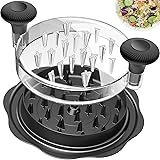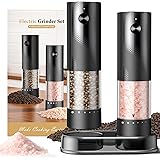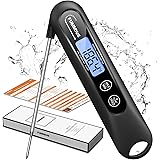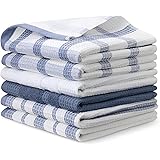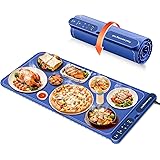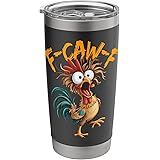The Hearth’s Hidden Blueprint: Demystifying Parts of a Fireplace

Ukeetap 10" Pro Chicken Shredder Tool Twist Large for Kitchen, BPA-Free Food-Safe Meat Grinder, Visible Chicken Breast Meat Shredder with Strong Anti-Slip Bottom & Ergonomic Handle, Black
$9.99 (as of November 11, 2025 19:44 GMT +00:00 - More infoProduct prices and availability are accurate as of the date/time indicated and are subject to change. Any price and availability information displayed on [relevant Amazon Site(s), as applicable] at the time of purchase will apply to the purchase of this product.)Electric Salt and Pepper Grinder Set - Rechargeable Automatic Salt and Pepper Shakers, Kitchen Appliances with External Adjustable Coarseness, Larger Hopper for Cooking, Home Gifts(2 Pack,Black/Black)
$23.99 (as of November 11, 2025 19:44 GMT +00:00 - More infoProduct prices and availability are accurate as of the date/time indicated and are subject to change. Any price and availability information displayed on [relevant Amazon Site(s), as applicable] at the time of purchase will apply to the purchase of this product.)BNBUN Bamboo Cutting Board for Kitchen, Wooden Cutting Board 3-Piece Set with Non-Slip Mat Deep Juice Groove and Built-In Handles, Wood Cutting Board for Meat Vegetables Fruit Ideal Gift for the Home
$29.99 (as of November 11, 2025 19:44 GMT +00:00 - More infoProduct prices and availability are accurate as of the date/time indicated and are subject to change. Any price and availability information displayed on [relevant Amazon Site(s), as applicable] at the time of purchase will apply to the purchase of this product.)Bidobibo Bear Straw Cup, Cute Baby Straw Cups Glass, Honey Bear Cup with Straws, Cute Mugs for Coffee Drinks 20oz (1 PC)
$29.99 (as of November 11, 2025 19:44 GMT +00:00 - More infoProduct prices and availability are accurate as of the date/time indicated and are subject to change. Any price and availability information displayed on [relevant Amazon Site(s), as applicable] at the time of purchase will apply to the purchase of this product.)Food Vacuum Sealer Machine, 75KPA Strong Suction, Dry/Wet Modes, 20 Vacuum Seal Bags for Food, Digital Countdown Timer, Compact Lightweight, Ideal for Home Kitchen Use
$24.99 (as of November 11, 2025 19:44 GMT +00:00 - More infoProduct prices and availability are accurate as of the date/time indicated and are subject to change. Any price and availability information displayed on [relevant Amazon Site(s), as applicable] at the time of purchase will apply to the purchase of this product.)8 Blade All-in-1 Vegetable Chopper Mandoline Slicer with Container, Food Chopper, Onion Chopper, Veggie Cutter for Salad, Kitchen Gadgets Accessories Essentials, White
$19.99 (as of November 11, 2025 19:44 GMT +00:00 - More infoProduct prices and availability are accurate as of the date/time indicated and are subject to change. Any price and availability information displayed on [relevant Amazon Site(s), as applicable] at the time of purchase will apply to the purchase of this product.)FUMMDUS Meat Thermometer Digital, 3S Instant Read Food Thermometer for Cooking with Backlight & Magnet, Foldable Temperature Probe Kitchen Gadgets Essentials for Turkey BBQ Grill Smoker Candy
$9.99 (as of November 11, 2025 19:44 GMT +00:00 - More infoProduct prices and availability are accurate as of the date/time indicated and are subject to change. Any price and availability information displayed on [relevant Amazon Site(s), as applicable] at the time of purchase will apply to the purchase of this product.)Amazon Basics Organic Cotton Waffle Kitchen Dish Towels - Ultra Absorbent, Quick Drying, Lint-Free, 15 x 25 inches, 6-Pack (4 Navy Strip/Checker, 1 White, 1 Solid Navy)
Now retrieving the price.
(as of November 11, 2025 19:44 GMT +00:00 - More infoProduct prices and availability are accurate as of the date/time indicated and are subject to change. Any price and availability information displayed on [relevant Amazon Site(s), as applicable] at the time of purchase will apply to the purchase of this product.)Warming Mat for Food Extra Large 32"x15", Electric Silicone Food Warmer Trays for Chafing Dishes & Buffet,Portable Countertop Food Warmers for Parties, 7-Level Temp 8-Hour Timer, Blue
$49.99 (as of November 11, 2025 19:44 GMT +00:00 - More infoProduct prices and availability are accurate as of the date/time indicated and are subject to change. Any price and availability information displayed on [relevant Amazon Site(s), as applicable] at the time of purchase will apply to the purchase of this product.)F-Caw-F Funny Chicken Humor F-Caw-F Quote Rooster Meme Stainless Steel Insulated Tumbler
$18.69 (as of November 11, 2025 19:44 GMT +00:00 - More infoProduct prices and availability are accurate as of the date/time indicated and are subject to change. Any price and availability information displayed on [relevant Amazon Site(s), as applicable] at the time of purchase will apply to the purchase of this product.)There’s nothing quite like the warm, welcoming crackle of a fire on a cold evening. That cozy ambiance, however, is made possible by a complex architectural system working seamlessly behind the scenes. Understanding the anatomy of your fireplace is more than just a technical exercise—it’s the key to safer operation, more efficient heating, and smarter maintenance. Many homeowners are familiar with the mantel and the firebox, but the true magic lies in the hidden components that guide heat and smoke up and out of your home.
This definitive guide will take you on a detailed journey through all 13 parts of a fireplace explained, from the foundational footing to the protective chimney cap. We will demystify the purpose and function of each critical component, providing you with the knowledge to appreciate, operate, and care for your fireplace like a seasoned expert. By the end of this article, you will see your fireplace not just as a simple opening in the wall, but as a finely tuned system where every part plays a vital role.
Chapter 1: The Foundation and Support System
Every great structure begins with a solid foundation, and your fireplace is no exception. These lower components provide the literal and figurative support for the entire system, ensuring stability and safety.
1. The Footing: The Unseen Anchor
Beneath the floor and entirely out of sight lies the footing, the concrete base upon which the entire chimney and fireplace structure is built. This component is absolutely critical for safety and structural integrity.
- Function: The footing is designed to distribute the immense weight of the masonry chimney and fireplace safely into the ground. A standard brick chimney can weigh several tons, and without a proper footing, the structure could settle or even collapse.
- Key Characteristics: According to building codes, footings must extend at least six inches beyond each side of the chimney and be a minimum of 12 inches thick . This ensures a stable base that prevents shifting over time.
- Why It Matters: A cracked or sinking footing can lead to major structural damage throughout your entire fireplace system, manifesting as cracks in the firebox or brickwork. It is the most difficult component to repair, making its initial proper construction paramount.
2. The Hearth: The Stage for Your Fire
The hearth is the part of the fireplace you can both see and stand on. It serves as the “stage” for your fire and is one of the most important safety features.
- Function: The hearth is a non-combustible “floor” for the firebox and extends out into the room. Its primary purpose is to protect your home’s combustible flooring (like wood or carpet) from stray sparks, embers, and intense radiant heat .
- Key Characteristics: The hearth is typically constructed from heat-resistant materials such as brick, stone, tile, or concrete. Building codes mandate a specific size for the hearth extension (the part that projects into the room) to ensure adequate protection from rolling logs.
- Why It Matters: An improperly sized or damaged hearth poses a direct fire hazard. It is your first line of defense against accidental ignition of your floor, making its integrity non-negotiable.
3. The Firebox: The Heart of the Hearth
The firebox is the main chamber where you build and contain your fire. It is the “heart” of the fireplace, engineered to withstand extreme and repeated thermal stress.
- Function: The firebox contains the fire and its intense heat, directing smoke and gases upward toward the flue. Its design is crucial for efficient combustion and proper draft .
- Key Characteristics: The firebox is lined with a special, non-combustible firebrick and refractory mortar, which are designed to handle temperatures that would crack ordinary brick . Its dimensions must be correctly proportioned to the flue liner for the fireplace to draw smoke properly.
- Why It Matters: A cracked or deteriorating firebox cannot effectively contain heat. This can allow extreme temperatures to reach the surrounding combustible framing of your home, creating a severe fire risk. A well-maintained firebox is essential for both safety and performance.
Table: Foundation and Support Components at a Glance
| Component | Primary Function | Key Feature |
|---|---|---|
| Footing | Supports the chimney’s weight | Thick concrete base below ground level |
| Hearth | Protects floor from sparks and heat | Non-combustible extension in front of the firebox |
| Firebox | Contains the fire | Lined with heat-resistant firebrick |
Chapter 2: The Architectural Framework and Ventilation Control
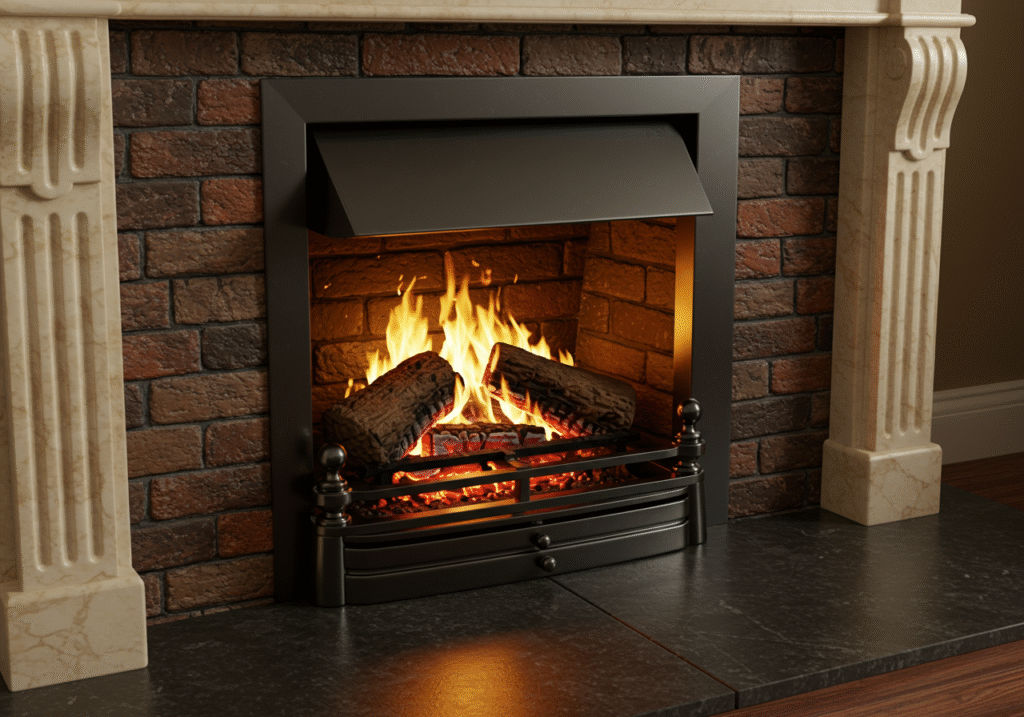
The components surrounding the firebox do more than just create a beautiful frame; they are integral to the safe and efficient operation of your fireplace, controlling airflow and managing the transition of smoke.
4. The Surround and Mantel: The Finishing Frame
The surround is the decorative facing that frames the fireplace opening, often made of wood, stone, or marble. The mantel is the shelf that projects from the top of the surround.
- Function: The surround protects the walls around the fireplace from heat and soot, while the mantel serves as a classic decorative element . However, their placement is governed by strict safety codes.
- Key Characteristics: Because they are often made of combustible materials like wood, they must be installed with specific clearance from the fireplace opening. The required distance increases based on how far the mantel projects from the wall .
- Why It Matters: A mantel or surround placed too close to the firebox opening can overheat, dry out, and eventually ignite. Proper clearance is a critical fire safety consideration that should never be compromised for aesthetics.
5. The Lintel: The Unsung Structural Hero
Directly above the fireplace opening, supporting the masonry above it, lies the lintel. This heavy horizontal support beam is often hidden behind the surround or mantel.
- Function: The lintel bears the weight of the masonry above the fireplace opening, preventing it from collapsing into the firebox .
- Key Characteristics: Lintels are typically made of solid steel or reinforced concrete. Any defect in this area can allow the extreme heat of the fire to transfer to adjacent combustible parts of the home’s frame.
- Why It Matters: A failed or compromised lintel is a serious structural issue that can lead to cracks in the firebox and chimney above it, requiring immediate professional attention.
6. The Damper: The Throat’s Gatekeeper
Located just above the firebox and below the smoke chamber, the damper is a movable plate or valve that acts as the primary seal for your fireplace when it is not in use.
- Function: The damper’s primary role is to control the draft of an open fireplace and to seal the chimney flue when the fireplace is cold . An open damper allows smoke to exit; a closed damper prevents warm indoor air from escaping up the chimney.
- Key Characteristics: Dampers come in various styles, including throat dampers (the most common, located just above the firebox) and top-sealing dampers (located at the top of the chimney, which provide a superior air seal).
- Why It Matters: A damper that is stuck open will cause significant heat loss from your home, increasing your energy bills. A damper that is closed when a fire is lit will force deadly smoke and carbon monoxide back into your living space. It is the most important operational control you have.
Chapter 3: The Smoke and Exhaust Pathway
Once smoke leaves the firebox, it enters a sophisticated system designed to channel it quickly and safely out of your home. Understanding this pathway is key to preventing smoky rooms and chimney fires.
7. The Smoke Shelf: The Downdraft Defender
Directly behind the damper and forming the bottom of the smoke chamber is the smoke shelf. This often-overlooked component is a simple but brilliant piece of fireplace engineering.
- Function: The smoke shelf serves two key purposes. First, it deflects cold downdrafts that can occasionally blow down the chimney, preventing them from blowing smoke and ash into the room. Second, it catches rain, debris, and small amounts of soot that may fall down the flue .
- Key Characteristics: The smoke shelf is a horizontal, concave surface that acts as a buffer zone between the firebox below and the smoke chamber above.
- Why It Matters: A properly sized and shaped smoke shelf is essential for a smoke-free fire. Without it, even a slight downdraft would easily disrupt the upward flow of smoke, causing it to spill into your home.
8. The Smoke Chamber: The Transition Tunnel
Above the smoke shelf, the walls begin to funnel inward, forming the pyramid-shaped smoke chamber. This is the transition zone that connects the wide fireplace opening to the narrow chimney flue.
- Function: The smoke chamber compresses and guides the rising smoke from the large firebox into the smaller flue liner, accelerating its flow .
- Key Characteristics: In older fireplaces, the smoke chamber walls are often rough and stepped. Modern best practices call for these walls to be “parged” or smoothed with a special refractory mortar to reduce turbulence and improve airflow.
- Why It Matters: A rough, unparged smoke chamber creates resistance and turbulence, which hinders draft and can cause smoke to back up into the room. It is also a prime location for dangerous creosote buildup.
9. The Flue Liner: The Protected Passageway
Running the entire vertical length of your chimney is the flue liner. This is the dedicated passageway that carries combustion gases and smoke from the smoke chamber to the outdoors.
- Function: The flue liner contains the exhaust gases, protects the chimney structure from heat and corrosive combustion byproducts, and provides a correctly sized channel for maintaining a proper draft .
- Key Characteristics: Flue liners are most commonly made of clay tiles, but can also be stainless steel or cast-in-place concrete. A liner must be continuous and free of cracks or gaps to be safe.
- Why It Matters: A cracked or deteriorating flue liner is one of the most hazardous fireplace conditions. It allows intense heat to transfer to the surrounding combustible building materials (like wood framing), which is a leading cause of chimney fires. A sound flue liner is non-negotiable for safe operation.
10. The Chimney: The Structural Shaft
The chimney is the brick-and-mortar structure that surrounds and protects the flue liner. It is the most visible exterior part of your fireplace system.
- Function: The chimney’s primary job is to house the flue liner and isolate its heat from any combustible parts of your home’s structure . It also provides the necessary height to create a strong draft.
- Key Characteristics: Building codes specify minimum height requirements (typically at least 3 feet above the roof and 2 feet higher than anything within 10 feet) to ensure sparks can dissipate and the draft is strong enough to pull smoke upward .
- Why It Matters: Over time, the brick and mortar of the chimney can deteriorate due to weather and freeze-thaw cycles, a process known as spalling. This can compromise the structure’s stability and allow water to enter, which damages the flue liner and the interior of your home.
Table: The Smoke’s Journey Up and Out
| Component | Stage in the Journey | Key Safety Role |
|---|---|---|
| Smoke Shelf | Entry Point | Deflects downdrafts and falling debris |
| Smoke Chamber | Compression Zone | Smoothly funnels smoke into the flue |
| Flue Liner | Protected Highway | Contains heat and corrosive gases |
| Chimney | Structural Tower | Isolates heat from house framing |
Chapter 4: The Protective Crown and Accessories
The final components of your fireplace system are located at the very top and are your first line of defense against the elements. Meanwhile, essential accessories inside the firebox improve its performance.
11. The Chimney Cap and Spark Arrestor: The First Line of Defense
Crowning the top of your flue is the chimney cap, often equipped with a mesh spark arrestor.
- Function: The chimney cap prevents rain, snow, animals, and debris from entering the flue. The spark arrestor mesh contains hot embers and sparks that rise with the smoke, preventing them from escaping and landing on your roof where they could start a fire .
- Key Characteristics: A good quality cap is made of durable, corrosion-resistant metal like stainless steel or copper. The mesh should be small enough to block sparks but large enough not to clog easily with soot.
- Why It Matters: Without a cap, your flue is vulnerable to water damage, animal nests that block ventilation, and destructive chimney fires caused by escaped sparks. It is a small, inexpensive component that prevents enormous problems.
12. The Fire Grate: The Foundation for Your Fire
Inside the firebox, the fire grate is a simple but important accessory. This is the sturdy metal rack that you place your firewood on.
- Function: The grate elevates the logs off the floor of the firebox. This allows air to circulate underneath the fire, promoting more complete combustion and a hotter, more efficient burn .
- Key Characteristics: Grates are typically made of heavy-duty cast iron or steel. An elevated fire burns cleaner and produces less smoke because it has better access to oxygen.
- Why It Matters: Building a fire directly on the firebox floor can smother it, leading to a cooler, smokier burn and faster accumulation of ash. Using a grate is a simple way to improve your fireplace’s efficiency and performance.
13. The Ash Dump and Clean-Out Door: The Ash Management System
Many traditional masonry fireplaces are built with a built-in system for managing ash. This includes an ash dump in the floor of the firebox and a clean-out door located in the basement or foundation.
- Function: The ash dump is a small, trap-doored opening that allows you to sweep ashes from the firebox down into a pit below. The clean-out door, located at the bottom of this pit, provides external access to remove the accumulated ash safely and with minimal mess .
- Key Characteristics: This system centralizes ash disposal and prevents you from having to carry buckets of ash through your living space. The ash dump door must form a tight seal to prevent air from being drawn into the firebox from below.
- Why It Matters: Proper ash management is part of good fireplace hygiene. A clean firebox allows for better airflow, and safely storing ash in a dedicated metal pit reduces the risk of accidental fires, as ashes can retain hot embers for days.
Conclusion: A System of Interdependent Parts
As we have explored in detail, a fireplace is far more than a simple hole in the wall. It is a carefully engineered system of 13 integral parts, each with a distinct and vital role to play. From the unseen footing to the protective chimney cap, every component must be in good working order for the entire system to function safely and efficiently.
Understanding all 13 parts of a fireplace explained empowers you as a homeowner. You can now identify potential issues, communicate more effectively with chimney professionals, and appreciate the intricate dance of physics and engineering that occurs every time you light a fire. This knowledge ensures that the heart of your home remains a source of comfort and joy, not hidden danger. Remember, an annual inspection by a certified chimney sweep is the best way to ensure that every part of this complex system remains in safe, working order for years to come.

